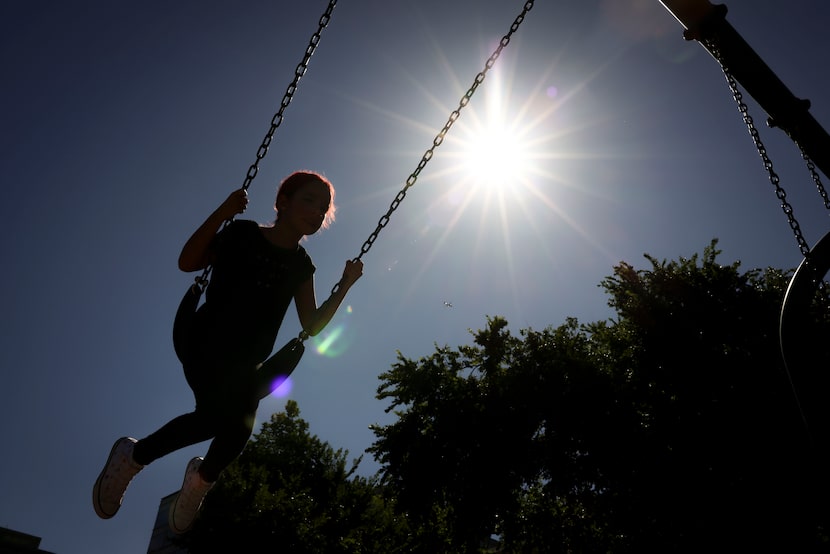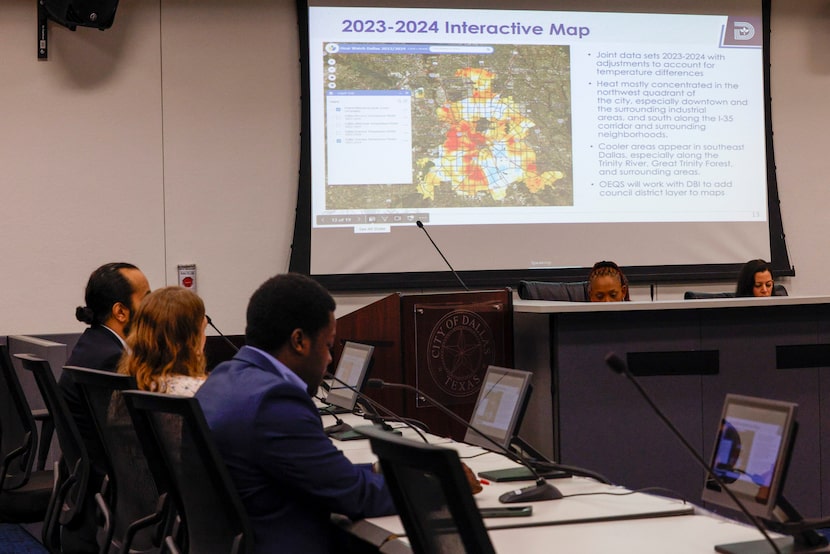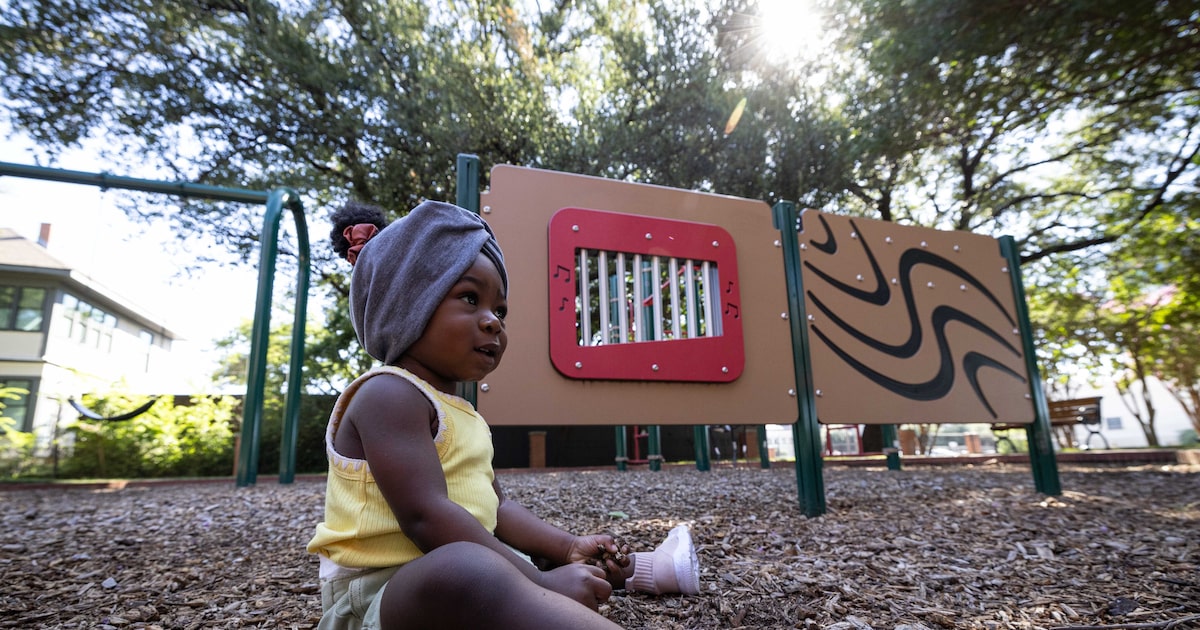When Sara McQuillen returned to Texas after nearly a decade in Washington, D.C., she braced herself for the summer heat.
The 33-year-old lawyer and mother of three knows Texas summers all too well, but her children — all under age 6 — had only experienced the state’s sweltering grip during brief visits.
“We have visited in the summer in the past,” said McQuillen, who lives in Keller with her family, “but it’s not the same as living here and having day after day of crazy heat until like October.”
As Dallas reaches triple-digit temperature this summer, McQuillen is determined to keep her kids safe — taking them outside during the cooler early mornings, finding indoor activities at midday and making sure they stay well-hydrated. She has good reason for concern.
Breaking News
In a recent study published in the journal Academic Pediatrics, physicians at UT Southwestern Medical Center found the proportion of emergency room visits for heat-related illnesses among children in the Dallas area rose 170% between 2012 and 2023. These visits were more common during the hottest months of the year, underscoring the seasonal risk.
The findings echo other research showing heat-related illnesses are increasing not just in the United States but worldwide, said Dr. Henry Xiang, a professor of medicine and epidemiology at The Ohio State University, who was not involved in the study. As climate change drives more frequent and intense heat waves, the study emphasizes the urgent need to protect vulnerable groups such as children from the dangers of extreme heat, Xiang said.
Little bodies not great at cooling
Texas may be famous for its sweltering summers, but studies show the state — and much of the country — is experiencing even hotter weather than before.
Extreme summer heat in Texas has reached levels not seen since the early 20th century and is projected to surpass those records by 2036, according to a 2024 Texas A&M climate report funded by Texas 2036, a nonpartisan public policy group. The number of triple-digit days is expected to be nearly four times higher by 2036 than it was in the 1970s and 1980s.
Too much heat isn’t safe for anyone, but children, like older adults, are especially vulnerable. Their bodies generate more heat relative to their size due to higher metabolic rates, but they cool down less efficiently because they sweat at a lower rate, research shows.
 Anabelle Herrera, 9, swings in the backlight of the July sun, on Thursday, July 24, 2025, at Pike Park in Dallas. (Shafkat Anowar / Staff Photographer)
Anabelle Herrera, 9, swings in the backlight of the July sun, on Thursday, July 24, 2025, at Pike Park in Dallas. (Shafkat Anowar / Staff Photographer)
Kids are also more prone to dehydration because a larger share of their body weight is water, and unlike adults, they may not recognize when they need to rest or rehydrate. Without close supervision, children can quickly overheat — especially during prolonged outdoor activity or in places without adequate cooling, said Dr. Taylor Merritt, the study’s first author and a pediatric resident at UT Southwestern Medical Center.
Merritt became interested in studying heat-related illnesses in children when she arrived at UT Southwestern three years ago to start her pediatric residency.
“During my first summer here, which was quite hot, we had a whole football team of players on the floor,” Merritt said. “When they were exercising during their summer practices, they all, unfortunately, came in with heat-related illnesses. A lot of them had rhabdomyolysis, which is [a] disease of muscle breakdown … So it really prompted me to want to know if this was happening every summer. What are those kinds of trends looking like?”
She and her colleagues at UT Southwestern reviewed electronic health records of Children’s Medical Center Dallas and Children’s Medical Center Plano, searching for emergency room visits involving children treated for heat-related illnesses. These conditions range from fainting and heat edema, which causes swelling of the feet and other extremities as blood vessels expand to release heat, to more serious outcomes such as heat stroke and rhabdomyolysis.
The researchers analyzed more than two million emergency room visits from May 2012 through September 2023, also considering a child’s age, sex, ethnicity and their neighborhood of residence — factors that offered insight into their socioeconomic background and environmental conditions.
Merritt and her colleagues observed a steady rise — amounting to a 170% increase — in heat-related emergency room visits over the 12-year study period, even when taking into account the dip in emergency room visits during the COVID-19 pandemic.
“We did still see a dip in those years — we think kids were maybe not playing [outside] and doing sports as much,” Merritt said. “But after that we saw a pretty steady increase, and before [the pandemic], we were seeing a pretty steady increase.”
The researchers found for every 1 degree Fahrenheit increase in temperature, there were an additional 0.64 heat-related illness cases per 10,000 emergency room visits. Most of the affected children were under age 12, Hispanic, enrolled in government insurance programs or lived in neighborhoods with limited socioeconomic opportunity. Children diagnosed with rhabdomyolysis were less likely to come from these groups.
While children with rhabdomyolysis, who Merritt said tended to be athletes, male and in their teens, were admitted to the hospital 63% of the time, children with other heat-related illnesses were discharged from the emergency room in 96% of cases.
Vigilance against the heat
These findings come as an estimated 559 million children worldwide are exposed to frequent heat waves, according to UNICEF’s Children’s Environmental Health Collaborative. By 2050, every child on Earth is expected to face even more frequent and intense heat events.
Xiang of The Ohio State University said the new study supports his own findings on heat-related emergency room visits at the national level across all age groups. Using data from the Nationwide Emergency Department Sample — the largest all-payer emergency department database in the U.S. — Xiang and his colleagues analyzed national trends between 2008 and 2020. Their research, published in 2022, revealed a significant rise in emergency room visits for heat-related conditions across the country and for all ages, although people aged 18 to 49 accounted for the most heat-related emergency room visits.
People living in areas of poverty, which are called limited resource areas, make up a disproportionately high share of emergency room visits for heat-related illnesses, Xiang said.
He added some regions appeared to be more affected than others, with the South — including Texas — bearing the greatest burden. In the 12-year period studied, the South accounted for nearly 52% of all heat-related emergency room visits in the U.S., while the Northeast saw the fewest at around 10%.
Merritt said the findings highlight the urgent need for improved access to cooling, such as shaded play areas and air-conditioned public spaces, in low-opportunity neighborhoods across the Dallas-Fort Worth metroplex.
A 2021 study from the University of California, San Diego, found low-income neighborhoods and communities with large Black, Hispanic and Asian populations face significantly hotter conditions than wealthier, predominantly white areas. The culprit is the urban heat island effect, where asphalt, concrete and other structures tend to trap and radiate heat, while greener spaces — parks, rivers and tree-lined streets — stay much cooler.
In Dallas, urban heat islands also tend to be localized in areas with high concentrations of Black and Hispanic residents, such as West and southern Dallas, researchers of the 2017 Urban Heat Island Management Study told The Dallas Morning News in 2022.
The study, conducted by the Texas Trees Foundation, found implementing green strategies, such as planting and preserving trees, could bring temperatures down by 15 degrees Fahrenheit on hot summer days and reduce heat-related deaths in densely populated areas by more than 20%.
 Office of Environmental Quality and Sustainability staff present an urban heat island project update during an Environmental Commission meeting at Dallas City Hall, Wednesday, March 12, 2025, in Dallas.(Elías Valverde II / Staff Photographer)
Office of Environmental Quality and Sustainability staff present an urban heat island project update during an Environmental Commission meeting at Dallas City Hall, Wednesday, March 12, 2025, in Dallas.(Elías Valverde II / Staff Photographer)
Xiang said in the future, wearable devices like smartwatches could help monitor children’s heat exposure during hot summer months. Similar technology is being tested by the U.S. military to prevent heat-related illnesses during training, and construction companies such as Texas-based Rogers-O’Brien are using wearables devices to protect their construction workers, another high-risk group exposed to extreme heat. But until such tools are proven effective for children, Merritt said the best defense remains parents keeping a close eye on their kids and watching for any sign of heat stress.
Some signs of heat stress and exhaustion that Merritt noted include:
- Pale, moist or flushed skin
- Tiredness
- Nausea or vomiting
- Heart racing
- Behavioral or mental changes
If your child shows any of these symptoms, Merritt recommended seeking immediate medical attention.
There are ways parents can safeguard their children from heat-related illnesses. McQuillen of Keller has been following many of them: timing outdoor activities for cooler times of the day, ensuring water breaks and using sun protection such as applying sunscreen.
“Everywhere we go, no matter what time of year, we bring water,” McQuillen said. “[My kids] never finish [their water] during an outing or even over the course of a day. This year, we are all out of water before we’re even home.”
According to Children’s Health, other tips include seeking shade as much as possible when outside, wearing loose-fitting and moisture-wicking clothing rather than cotton and taking regular breaks from physical activity.
Miriam Fauzia is a science reporting fellow at The Dallas Morning News. Her fellowship is supported by the University of Texas at Dallas. The News makes all editorial decisions.
